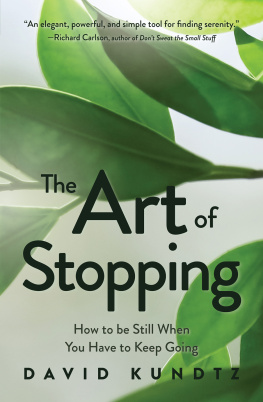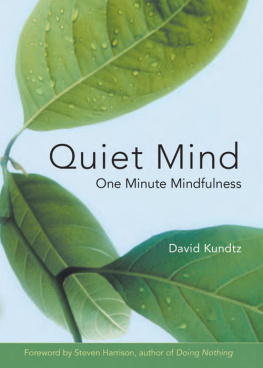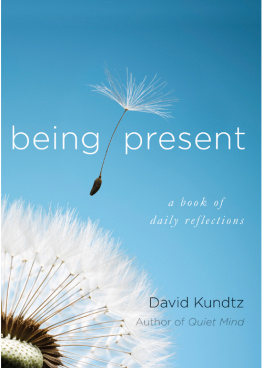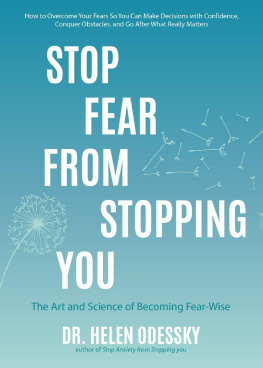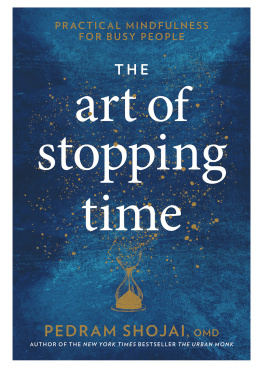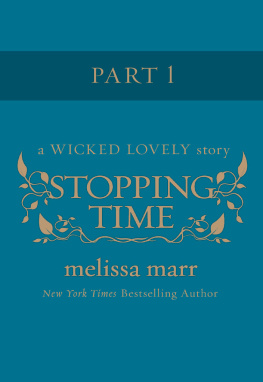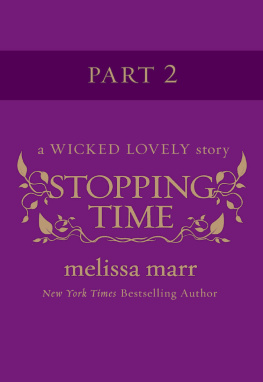
Copyright 1998 by David J. Kundtz, S.T.D.
All Rights Reserved. No part of this book may be used or reproduced in any manner whatsoever without written permission, except in the case of brief quotations in critical articles or reviews. For information, contact Conari Press, 2550 Ninth Street, Suite 101, Berkeley, CA 94710-2551.
All acknowledgments of permission to reprint previously published material can be found on pp. 26970, which constitute an extension of this copyright page.
Conari Press books are distributed by Publishers Group West.
Cover Design: Ame Beanland
Cover Illustration: Marnie Johnson Grenier
Book Design and Composition: Jennifer Brontsema
Chart on page 135: John Lomibao Design
ISBN: 1-57324-109-1
Library of Congress Cataloging-in-Publication Data
Kundtz, David, 1937
Stopping : how to be still when you have to keep going / David Kundtz; foreword by Richard Carlson.
p. cm.
Includes bibliographical references.
ISBN 1-57324-109-1 (trade paper)
1. Quietude. I. Title.
BJ1533.Q5K85 1998
158dc21
97-31202
Printed in the United States of America on recycled paper.
1 3 5 7 9 10 8 6 4 2
www.redwheelweiser.com
www.redwheelweiser.com/newsletter
To the memory of my father whose example taught me about Stopping. To the memory of my mother who always encouraged me to write.
CONTENTS
I
II
III
IV
V
Foreword
When I first looked at Stopping: How to Be Still When You Have to Keep Going, I realized immediately that I was in familiar territory. In fact, it didn't take me long to locate in my own work a very specific expression of what Stopping is all about: Virtually every day, I stop whatever I'm doing to enjoy the sunrise... (Don't Sweat the Small Stuff... and it's all small stuff). And this is just one of many examples. Yes, Stopping as defined by Dr. Kundtzdoing nothing in order to wake up and remember who you areis something that has been part of my life for a long time.
What we owe David Kundtz is credit for conceptualizing a simple yet profound reality and offering to us an elegant and powerful tool for finding the serenity and stillness that so easily escapes us as we cope with too-busy lives.
Stopping is a happy marriage of the riches of many of the world's contemplative and mystical traditions, with the insight and awareness of contemporary psychology. Just what the world needs right now, it seems to me.
Finally, because it gives us perspective, because it encourages us to put first things first, and because it keeps us awake and aware, Stopping is an ideal way to remember something important about the vast majority of things that bother and upset us: It's all small stuff.
Richard Carlson, Ph.D.

I
Stopping at the Speed of Light
The dogmas of the quiet past, are inadequateto the stormy present....As our case is new, so we must think anewand act anew.
ABRAHAM LINCOLN
1
Facing the Mountain of Too Much
It's too much, Mary Helen told me, way too much. I just can't deal with it all! Then she gave in to tears. Mary Helen, a successful and intelligent woman of thirty-eight, with a thriving career and a loving family, was close to the end of her rope.
Any observer in my counseling office that day would clearly have seen that Mary Helen was in trouble: anxious, stressed, unfocused, irritable, unable to sleep, overwhelmed by life, and frustrated with her inability to manage it. She was angry at herself for her inability to cope and angry at me because I was the one to whom she had admitted it.
Although she was not aware of it, she did know what the problem was. It was the first thing she said: too much. Upon further exploration, I found no underlying psychosis, no debilitating personality disorder, no family-of-origin dysfunction making a sudden midlife appearance, nor a marriage about to crash on the rocks of incompatibility. Just that life had become too much.
Just that life had become too much? Hardly. Although the problem may seem well known, its vastness, depth, and long-term implications are still far from our conscious recognition. As with any hidden enemy, the contemporary problem of too much has its way with all of us. The damage is extremely severe and is sometimes even life threatening.
Do you sometimes feel like Mary Helen, overwhelmed or emotionally numbed by the pace and sheer quantity of life? Are you reluctantly prevented by your overloaded schedule from keeping your true priorities? Do you feel unable to do all the things you need to do and still have time for yourself? Have you come to realize that it's been too long since you've enjoyed real, satisfying, and regular leisure? If so, you've found the right book.
Do you have a desire to give more attention to the spiritual aspects of your lifeyour truly important meanings and values but have been frustrated in trying to transform that desire into a real practice? You will find nourishment here.
Or have you been frustrated with complicated, time-consuming, or impractical systems of meditation and slowing down that don't really work for you? You can anticipate success through the suggestions found in this book.
Most of us in this hurry-up, e-mail world of instant response are feeling the same sense of overload that my client Mary Helen felt. Indeed, the primary challenge to successful human life in the postmodern, millennial world is the challenge of too much: too much to do; too much to cope with; too much distraction; too much noise; too much demanding our attention; or, for many of us, too many opportunities and too many choices. Too much of everything for the time and energy available.
We all have been feeling, at least on a subliminal level, the choices, demands, and complexities of life increase with every passing year. We have more to be, more to do, more places to go, and more things we want or need to accomplish. But the day remains twenty-four hours; the year, the same twelve months. The amount of activity constantly increases, but both the amount of time into which it must fit and the human energy with which it must be met, at best, remain the same.
Even though my client Mary Helen named her problem It's way too much. I just can't deal with it allshe didn't recognize it, first, as something very serious and, second, as something new. Rather, she saw it just as one more of life's irritations that she should be able to deal with. This attitude reveals a key characteristic of the problem of too much: It passes itself off as something it is not. It says, I am the same old problem you have been dealing with all your life, you can handle me. But the reality is that we can'tand believing we can is part and parcel of the problem.
Why don't we see it coming? The answer is as simple as it is clear: it is masquerading, and the purpose of a masquerade is to make you think it's something else. We are all like Mary Helen, saying to ourselves, This should not be a serious problem! Because it looks and feels like the same old problem of being just too busy and in the past we have been able to handle it with the coping strategies available to us, we miss its seriousness and power.
It's time to rip off the mask from the problem of too much and reveal the seriously damaging monster that is destroying too many lives and too many families. Modern life has become impossible to cope with in the same old ways we learned as children and young adults.
Next page

